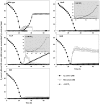Expression of nitrous oxide reductase in Paracoccus denitrificans is regulated by oxygen and nitric oxide through FnrP and NNR
- PMID: 22174385
- PMCID: PMC3541799
- DOI: 10.1099/mic.0.054148-0
Expression of nitrous oxide reductase in Paracoccus denitrificans is regulated by oxygen and nitric oxide through FnrP and NNR
Abstract
The reductases performing the four steps of denitrification are controlled by a network of transcriptional regulators and ancillary factors responding to intra- and extracellular signals, amongst which are oxygen and N oxides (NO and NO2(-)). Although many components of the regulatory network have been identified, there are gaps in our understanding of their role(s) in controlling the expression of the various reductases, in particular the environmentally important N(2)O reductase (N(2)OR). We investigated denitrification phenotypes of Paracoccus denitrificans mutants deficient in: (i) regulatory proteins (three FNR-type transcriptional regulators, NarR, NNR and FnrP, and NirI, which is involved in transcription activation of the structural nir cluster); (ii) functional enzymes (NO reductase and N(2)OR); or (iii) ancillary factors involved in N(2)O reduction (NirX and NosX). A robotized incubation system allowed us to closely monitor changes in concentrations of oxygen and all gaseous products during the transition from oxic to anoxic respiration. Strains deficient in NO reductase were able to grow during denitrification, despite reaching micromolar concentrations of NO, but were unable to return to oxic respiration. The FnrP mutant showed linear anoxic growth in a medium with nitrate as the sole NO(x), but exponential growth was restored by replacing nitrate with nitrite. We interpret this as nitrite limitation, suggesting dual transcriptional control of respiratory nitrate reductase (NAR) by FnrP and NarR. Mutations in either NirX or NosX did not affect the phenotype, but the double mutant lacked the potential to reduce N(2)O. Finally, we found that FnrP and NNR are alternative and equally effective inducers of N(2)OR.
Figures


Similar articles
-
Fine-tuned regulation by oxygen and nitric oxide of the activity of a semi-synthetic FNR-dependent promoter and expression of denitrification enzymes in Paracoccus denitrificans.Microbiology (Reading). 2003 Dec;149(Pt 12):3405-3412. doi: 10.1099/mic.0.26546-0. Microbiology (Reading). 2003. PMID: 14663074
-
FnrP and NNR of Paracoccus denitrificans are both members of the FNR family of transcriptional activators but have distinct roles in respiratory adaptation in response to oxygen limitation.Mol Microbiol. 1997 Mar;23(5):893-907. doi: 10.1046/j.1365-2958.1997.2801638.x. Mol Microbiol. 1997. PMID: 9076727
-
Transcription regulation of the nir gene cluster encoding nitrite reductase of Paracoccus denitrificans involves NNR and NirI, a novel type of membrane protein.Mol Microbiol. 1999 Oct;34(1):24-36. doi: 10.1046/j.1365-2958.1999.01563.x. Mol Microbiol. 1999. PMID: 10540283
-
Metabolic regulation including anaerobic metabolism in Paracoccus denitrificans.J Bioenerg Biomembr. 1991 Apr;23(2):163-85. doi: 10.1007/BF00762216. J Bioenerg Biomembr. 1991. PMID: 2050653 Review.
-
Emerging principles of inorganic nitrogen metabolism in Paracoccus denitrificans and related bacteria.Antonie Van Leeuwenhoek. 1997 Feb;71(1-2):33-41. doi: 10.1023/a:1000113824961. Antonie Van Leeuwenhoek. 1997. PMID: 9049016 Review.
Cited by
-
Role of norEF in denitrification, elucidated by physiological experiments with Rhodobacter sphaeroides.J Bacteriol. 2014 Jun;196(12):2190-200. doi: 10.1128/JB.00003-14. Epub 2014 Apr 4. J Bacteriol. 2014. PMID: 24706737 Free PMC article.
-
Denitrifying community in coastal sediments performs aerobic and anaerobic respiration simultaneously.ISME J. 2017 Aug;11(8):1799-1812. doi: 10.1038/ismej.2017.51. Epub 2017 May 2. ISME J. 2017. PMID: 28463234 Free PMC article.
-
Comparative Metagenomic Study of Rhizospheric and Bulk Mercury-Contaminated Soils in the Mining District of Almadén.Front Microbiol. 2022 Mar 7;13:797444. doi: 10.3389/fmicb.2022.797444. eCollection 2022. Front Microbiol. 2022. PMID: 35330761 Free PMC article.
-
Biokinetic Characterization and Activities of N2O-Reducing Bacteria in Response to Various Oxygen Levels.Front Microbiol. 2018 Apr 10;9:697. doi: 10.3389/fmicb.2018.00697. eCollection 2018. Front Microbiol. 2018. PMID: 29692767 Free PMC article.
-
Low probability of initiating nirS transcription explains observed gas kinetics and growth of bacteria switching from aerobic respiration to denitrification.PLoS Comput Biol. 2014 Nov 6;10(11):e1003933. doi: 10.1371/journal.pcbi.1003933. eCollection 2014 Nov. PLoS Comput Biol. 2014. PMID: 25375393 Free PMC article.
References
-
- Bergaust L., Mao Y., Bakken L. R., Frostegård A. (2010). Denitrification response patterns during the transition to anoxic respiration and posttranscriptional effects of suboptimal pH on nitrous [corrected] oxide reductase in Paracoccus denitrificans. Appl Environ Microbiol 76, 6387–6396. 10.1128/AEM.00608-10 - DOI - PMC - PubMed
-
- Bouchal P., Struhárová I., Budinská E., Sedo O., Vyhlídalová T., Zdráhal Z., van Spanning R. J. M., Kucera I. (2010). Unraveling an FNR based regulatory circuit in Paracoccus denitrificans using a proteomics-based approach. Biochim Biophys Acta 1804, 1350–1358. - PubMed
MeSH terms
Substances
LinkOut - more resources
Full Text Sources
Miscellaneous

